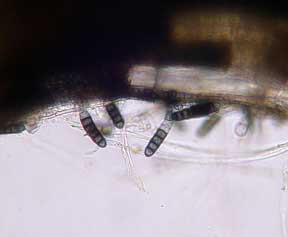Thielaviopsisa: A perennial problem
Editor’s note: This article is from the archives of the MSU Crop Advisory Team Alerts. Check the label of any pesticide referenced to ensure your use is included.
Many of you are familiar with black root rot, a disease caused by Thielaviopsis basicola, common on pansies, petunias, vinca and other bedding plants. As a plant pathologist this is one of my favorite pathogens to diagnose, one can look at infected roots under the microscope (see photo below) and readily see the distinctive large, dark, thick-walled spores. These well-protected spores can survive adverse conditions for extended periods of time, making it difficult to eradicate from greenhouses. Growers that are lax with sanitation often experience losses from black root rot annually.

What many growers don’t realize is that perennials are also susceptible to Thielaviopsis. Over the last 6 months or so I have seen an increasing number of perennials with black root rot. Thielaviopsis is a perennial problem in more ways than one!
Below is a list of the perennials received in the last year that were diagnosed with Thielaviopsis as well as the annuals most commonly seen with Thielaviopsis.
Most commonly seen susceptible annuals
Fuchsia
Pansy
Petunia
Verbena
Vinca
Recently diagnosed perennials
Dicentra (bleeding hart)
Gaillardia Geranium sp. (crane’s bill)
Heuchera (coral bells)
Phlox subulata (creeping phlox)
Phlox paniculata (garden phlox)
Viola sp.



 Print
Print Email
Email


